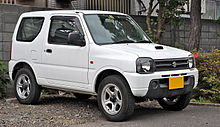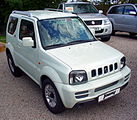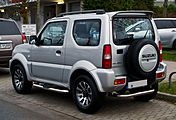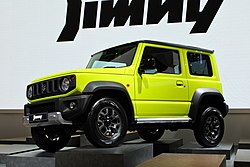Suzuki Jimny
| Suzuki Jimny | |
|---|---|
| Production period: | since 1998 |
| Class : | Off-road vehicle |
| Body versions : | Station wagon , convertible |
| Previous model: | Suzuki SJ / Samurai |
While all light SUVs from Suzuki have been offered in Japan under the name Suzuki Jimny since 1968 , in Europe it was only the third generation presented in summer 1998 as the successor to the Suzuki SJ, which had been built in 1981, that received this name.
First generation FJ (1998-2018)
| 1st generation | |
|---|---|
|
Suzuki Jimny (1998-2005) |
|
| Production period: | 1998-2018 |
| Body versions : | Station wagon , convertible |
| Engines: |
Otto engines : 1.3 liters (59–63 kW) Diesel engine : 1.5 liters (48–63 kW) |
| Length: | 3645-3805 mm |
| Width: | 1600-1645 mm |
| Height: | 1670-1705 mm |
| Wheelbase : | 2250 mm |
| Empty weight : | 1135-1260 kg |
As with the SJ models, the Jimny, introduced in 1998, is available in a closed version and as a convertible . Although it is not quite as off-road as its predecessor, it is more comfortable and more suitable for everyday use. In August 2005 there was a facelift . The model is also sold in Japan as Mazda AZ-Offroad with a 660 cm³ engine. The Mazda variant is a kei-car variant, which is also available from Jimny and does not correspond to the version available in Europe. The Jimny is also available with this engine.
The Jimny has very short overhangs at the front and back. This enables slope angles of up to 42 °. The models from summer 2005 onwards have a newly designed front section to accommodate the intercooler of the more powerful diesel variant. This reduced the approach angle to 36 °.
Both variants are powered by the 1.3-liter gasoline engine with 4 cylinders and 16 valves that is common at Suzuki. This has an output of 63 kW (86 PS) and, according to the manufacturer, consumes 7.2 liters of super unleaded in a third mix. The carbon dioxide emissions are 171 g / km.
Instead of the gasoline engine Suzuki also offers a 1.5-liter common rail - diesel engine from Renault with 48 kW (65 hp). This consumes 6.1 liters in a third mix with carbon dioxide emissions of 162 g / km. Like the gasoline engine, this engine has been producing 63 kW (86 hp) since summer 2005. At 200 Nm, the maximum torque of the diesel engine is considerably greater than that of the gasoline engine, which can deliver 110 Nm.
In Germany and Switzerland, the vehicle is only offered with selectable all-wheel drive and reduction gear , the 2WD version is no longer available. In normal operation, only the rear axle is driven. The car is allowed to pull 1300 kg in Germany, which corresponds to the unladen weight of the vehicle. Since the Jimny is designed as an off-road vehicle , the suspension is very hard.
The convertible version and the diesel models were manufactured for the European market by the Spanish off-road vehicle manufacturer Santana Motor , so that Santana (E) is listed as the manufacturer in the registration papers. The closed version has always been produced in Japan. The diesel variant has not been offered in Germany and Austria since 2009. Production of the convertible ended in 2011 when Santana was closed.
In autumn 2012 the Jimny was revised again. The front was modified with a new radiator grille and a changed bumper . At the rear, only the bumper was slightly adjusted. The off-road vehicle is also given new paintwork, upgraded equipment and new upholstery fabrics for the seats and headrests. No changes were made on the technical side.
The Jimny has also been produced in Brazil since mid-2012, but exclusively for the local market. The special models 4sun with folding roof like the earlier Skyline special models, 4sport and 4work with modified body and chassis, a snorkel and optionally larger tires are very popular there. In 2017 a convertible was presented, which is to be marketed under the name Canvas.
The engine has complied with the EURO 6 emissions standard since July 2015, with the performance data remaining unchanged at 62 kW (84 PS). Since then, ESP and a tire pressure monitoring system have been standard equipment. The interior has been slightly revised and the steering wheel has been adapted.
Technical specifications
| 1.3 | 1.3 | 1.3 | 1.3 | 1.5 D | 1.5 DDiS | |
|---|---|---|---|---|---|---|
| Construction period | 10 / 1998-12 / 2000 | 01/2001–05/2005 | 06 / 2005-06 / 2015 | 07 / 2015-04 / 2018 | 04/2004–11/2005 | 12/2005–04/2009 |
| Engine characteristics | ||||||
| Engine type | R4 petrol engine | R4 diesel engine | ||||
| Displacement | 1298 cc | 1328 cc | 1461 cc | |||
| Max. Power at min −1 | 59 kW (80 PS) / 6000 | 60 kW (82 PS) / 5500 | 63 kW (86 PS) / 6000 | 62 kW (84 PS) / 6000 | 48 kW (65 PS) / 3750 | 63 kW (86 PS) / 3750 |
| Max. Torque in min -1 | 104/4500 | 110/4500 | 110 Nm / 4100 | 160 Nm / | 200 Nm / 1750 | |
| Power transmission | ||||||
| Drive, as standard | Rear wheel drive | all wheel drive | ||||
| Drive, optional | (All wheel drive) | - | ||||
| Gearbox, as standard | 5-speed manual transmission | |||||
| Gearbox, optional | [4-speed automatic transmission (only in conjunction with all-wheel drive)] | [4-speed automatic transmission] | [4-speed automatic transmission ] | - | ||
| Readings | ||||||
| Top speed | 140 km / h [135 km / h] | 140 km / h | 140 km / h [135 km / h] | 130 km / h | 145 km / h | |
| Acceleration, 0-100 km / h | k. A. | 14.1 s [17.2 s] | k. A. | 17.0 s | ||
| Fuel consumption over 100 km (combined) | 8.0 l super (8.2 l super) | 7.8 l super | 7.1 l [7.3 l] super | 6.1 l diesel | ||
| CO 2 emissions (combined) | k. A. | 162 g / km [167 g / km] | 162 g / km | |||
| Tank capacity | 40 l | |||||
Second generation GJ (since 2018)
| 2nd generation | |
|---|---|
|
Suzuki Jimny (since 2018) |
|
| Production period: | since 2018 |
| Body versions : | Station wagon |
| Engines: |
Petrol engines : 1.5 liters (75 kW) |
| Length: | 3645 mm |
| Width: | 1645 mm |
| Height: | 1705 mm |
| Wheelbase : | 2250 mm |
| Empty weight : | 1165 kg |
In 2018 Suzuki presented a new generation of the Jimny. It was first launched in Japan in July 2018, followed by the European market on October 27, 2018. A convertible version is no longer available.
Technical specifications
| 1.5 | ||
|---|---|---|
| Construction period | since 10/2018 | |
| Engine characteristics | ||
| Engine type | R4 petrol engine | |
| Engine code | K15B | |
| Displacement | 1462 cc | |
| Max. Power at min −1 | 75 kW (102 PS) / 6000 | |
| Max. Torque in min -1 | 130 Nm / 4000 | |
| Power transmission | ||
| Drive, as standard | all wheel drive | |
| Drive, optional | - | |
| Gearbox, as standard | 5-speed manual transmission | |
| Gearbox, optional | [4-speed automatic transmission ] | |
| Readings | ||
| Top speed | 145 km / h [140 km / h] |
|
| Acceleration, 0-100 km / h | 12.8 s [k. A.] |
|
| Fuel consumption over 100 km (combined) | 6.8 l super [7.5 l super] |
|
| CO 2 emissions (combined) | 154 g / km [170 g / km] |
|
| Tank capacity | 40 l | |
| Emission standard according to EU classification | Euro 6d-TEMP | |
Santana Jimny
With the end of the cooperation between Suzuki and Santana in 2009, Suzuki announced that there was no customer support for the vehicles manufactured by Santana, as they were not Suzuki, but Santanas. The end of Santana in 2011 means for vehicles made in Spain, primarily the Jimny convertible, that a supply of vehicle-specific spare parts is no longer guaranteed. All other spare parts (e.g. engine or chassis components) are compatible with the Japanese-made Jimny and are still readily available. The vehicles manufactured by Santana have a chassis number that begins with the letters "VSE".
Vehicle owners also complain about the strongly fluctuating processing quality and severe corrosion of the vehicles manufactured by Santana.
Web links
Individual evidence
- ↑ Facelift for Suzuki Jimny
- ↑ New-Gen Suzuki Jimny And Jimny Sierra Launched In Japan - NDTV CarAndBike. In: auto.ndtv.com. July 6, 2018, accessed September 26, 2018 .
- ↑ Torsten Seibt, Patrick Lang, Stefan Cerchez: Suzuki Jimny (2018): Driving report, data, market launch: The smallest real off-roader in the video driving report. In: auto-motor-und-sport.de. September 18, 2018, accessed September 26, 2018 .









